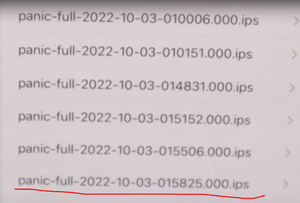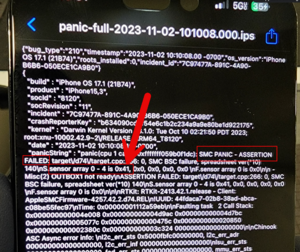More actions
| How To Fix an iPhone 14 Pro That Randomly Restarts | |
|---|---|
| Device | iPhone 14 Pro, iPhone 14 Pro Max |
| Affects part(s) | Main Logic Board |
| Needs equipment | Screwdrivers, known good parts, spudger |
| Difficulty | ◉◌◌◌ Easy |
| Type | Part replacement |
Problem description
There are many reasons that could cause an iPhone 14 Pro and iPhone 14 Pro Max to randomly restart every few minutes. For the iPhone 14 Pro series, there are some sensors within the parts of the phone that are required to be plugged in & detected. Otherwise, the phone restarts on its own.
The most common for iPhone 14 Pro series are:
- Proximity Flex - This is the flex that is attached to the screen. It can easily be liquid damaged or torn during a screen replacement.
- Charging Port Flex - This is the flex towards the bottom of the phone. It is easily damaged with a drop & the back glass is breaks. Or when someone has repaired the back glass.
- Power Button Flex - This is the flex that wraps around the logic board & controls the power button.
- 2 Layer Sandwich - Requires the bottom layer of the 2 layer motherboard.
Symptoms
- After a back glass repair, the iPhone will restart on its own every few minutes
- After a hard drop, the iPhone will restart every 3 minutes.
- After a screen repair, the iPhone will bootloop every 3 minutes
- After replacing the charging port flex, the device will auto restart on its own randomly.
- The iPhone will reboot randomly when using it.
- The iPhone will seem to freeze and restart every 2-5 minutes.
Solution
Diagnostic Steps
Before you start blindly replacing parts, it's important to try to confirm what is causing the restarting issue by reviewing the Panic Log file. This is a file that is generated by the Operating System, to document the fault causing the restart.

To find the panic log on the device, go to Settings-> Privacy-> Analytics & Improvements-> Analytics Data-> Scroll down to the files starting with "panic-full..." & click on the most recent dated file.
Then you'll want to scan through the text for keywords that may point you to the cause.
For this model, look for where it says "SMC PANIC - ASSERTION FAILED" ... "Sensor Array" .. "0x...."
If you see:
- 0x80000 - it's the Proximity Flex Cable
- Make sure this flex is plugged in
- Check that no flex is torn, liquid damaged, defective
- Test with OEM or Premium. Aftermarket Flexes have a high defect rate
- Diode mode the FPC connectors for any faults
- 0x40000 - It's the Charging Port Flex
- Make sure this flex is plugged in
- Check that no flex is torn, liquid damaged, defective
- Test with OEM or Premium. Aftermarket Flexes have a high defect rate
- Diode mode the FPC connectors for any faults
- 0x10000 - It's the Power Button Flex
- Make sure this flex is plugged in
- Check that no flex is torn, liquid damaged, defective
- Test with OEM or Premium. Aftermarket Flexes have a high defect rate
- Diode mode the FPC connectors for any faults
- 0xc0000 - It's the Prox Flex and Charging Port Flex
- Make sure both flex cables are plugged in
- Check that no flex is torn, liquid damaged, defective
- Test with OEM or Premium. Aftermarket Flexes have a high defect rate
- Diode mode the FPC connectors for any faults
- 0x180000 - It's the Prox Flex and Power Button Flex
- Make sure both flex cables are plugged in
- Check that no flex is torn, liquid damaged, defective
- Test with OEM or Premium. Aftermarket Flexes have a high defect rate
- Diode mode the FPC connectors for any faults
- 0x140000 - It's the Power Button and Charging Port Flex
- Make sure both flex cables are plugged in
- Check that no flex is torn, liquid damaged, defective
- Test with OEM or Premium. Aftermarket Flexes have a high defect rate
- Diode mode the FPC connectors for any faults
- 0x1c0000 - It's the Charging Port and Power Button Flex and Prox Flex
- Make sure all 3 flex cables are plugged in
- Check that no flex is torn, liquid damaged, defective
- Test with OEM or Premium. Aftermarket Flexes have a high defect rate
- Diode mode the FPC connectors for any faults
- 0x20000 - It's a sandwich board issue.
- This means the sandwich board has separated. It could require a sandwich reball or a bottom board swap.
- 0x41 - It's a battery data issue.
- Sometimes you'll see the battery percentage fluctuate or you'll randomly get a "non-genuine" message.
- Check the battery connector pins. Sometimes they can bend out & battery won't make good contact.
- Diode mode the battery connector pins & compare them to known good board
- Test with a known good battery
- Replace the battery connector

Alternatively, you can use a tool like the iDevice Panic Log Analyzer, which will download the panic logs from the device & display them on the PC & give you suggestions to possible solutions. It makes it easier to browse the panic log file.
Also check out www.PanicFull.com which allows you to upload the panic log file & have it analyzed for free.
Both of these tools just give suggestions, which aren't always correct, as there is no official solution list from Apple. So many solutions are just suggestions based on hearsay, rumors or just guesses.
For situations where you don't see the above examples, you'll have to read through the top portion of the panic log & try to decipher what could be the root cause. Look for keywords you may recognize.
Repair Steps
When trying to solve for these issues, make sure to replace the appropriate flex with an OEM or Premium flex.
It is also a good idea to keep a known good power button flex & charging port flex in your bench, for testing only. There are reports of even NEW flexes being bad. So you have to keep known good flexes on hand at all times, so you don't waste your time troubleshooting with possibly bad flexes.
In scenarios where you have the appropriate flexes plugged in, but it still restarts, then you either have:
- Bad or damaged flex
- Low quality aftermarket flex
- Other flex cables that are Liquid Damaged
Please note: You MUST have the required flex cables, (Prox flex, Charging port flex, Power Button Flex, Sandwich reballed) plugged in. Otherwise, it WILL restart. You cannot troubleshoot this step by unplugging the bad flex.
